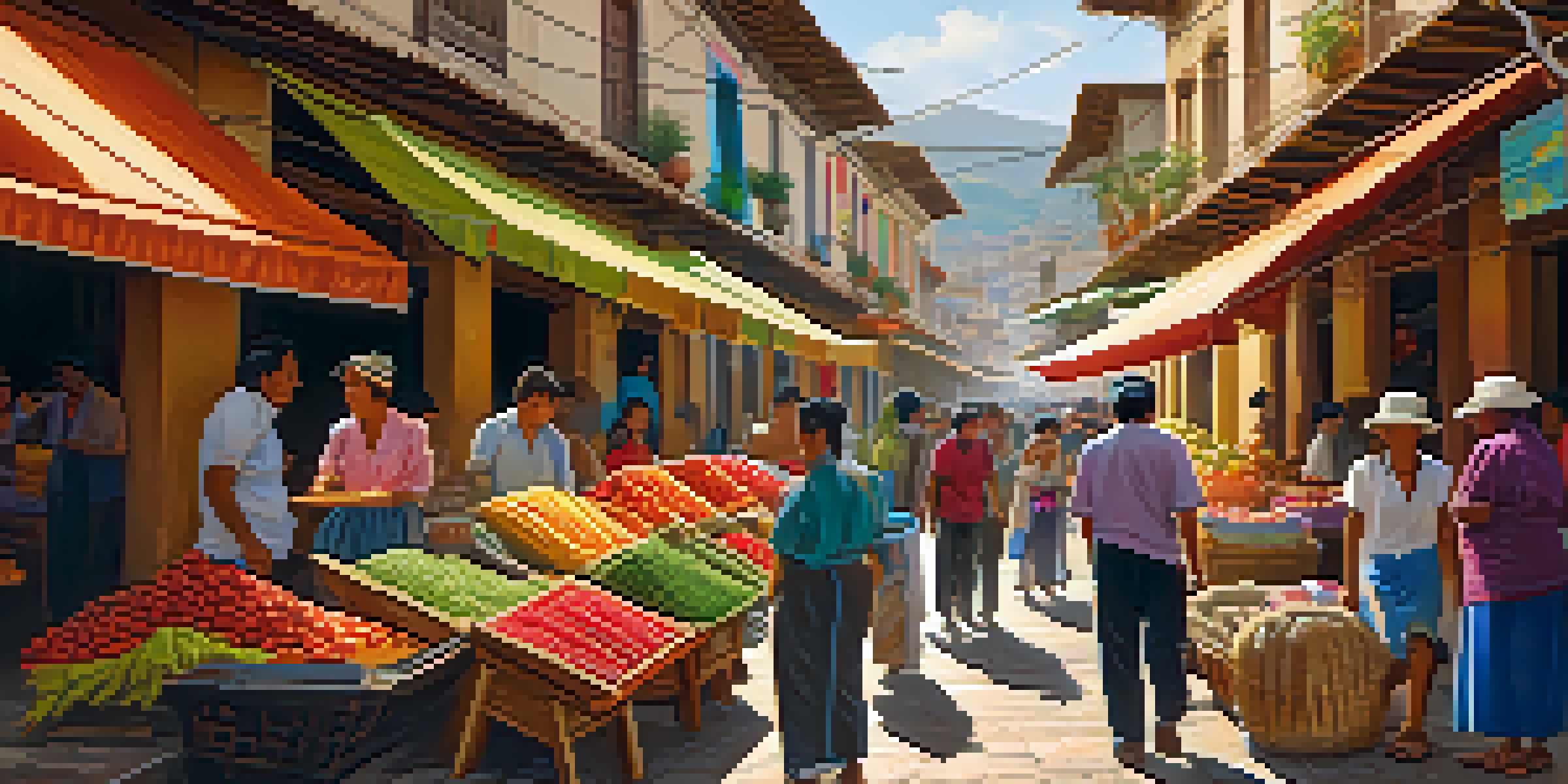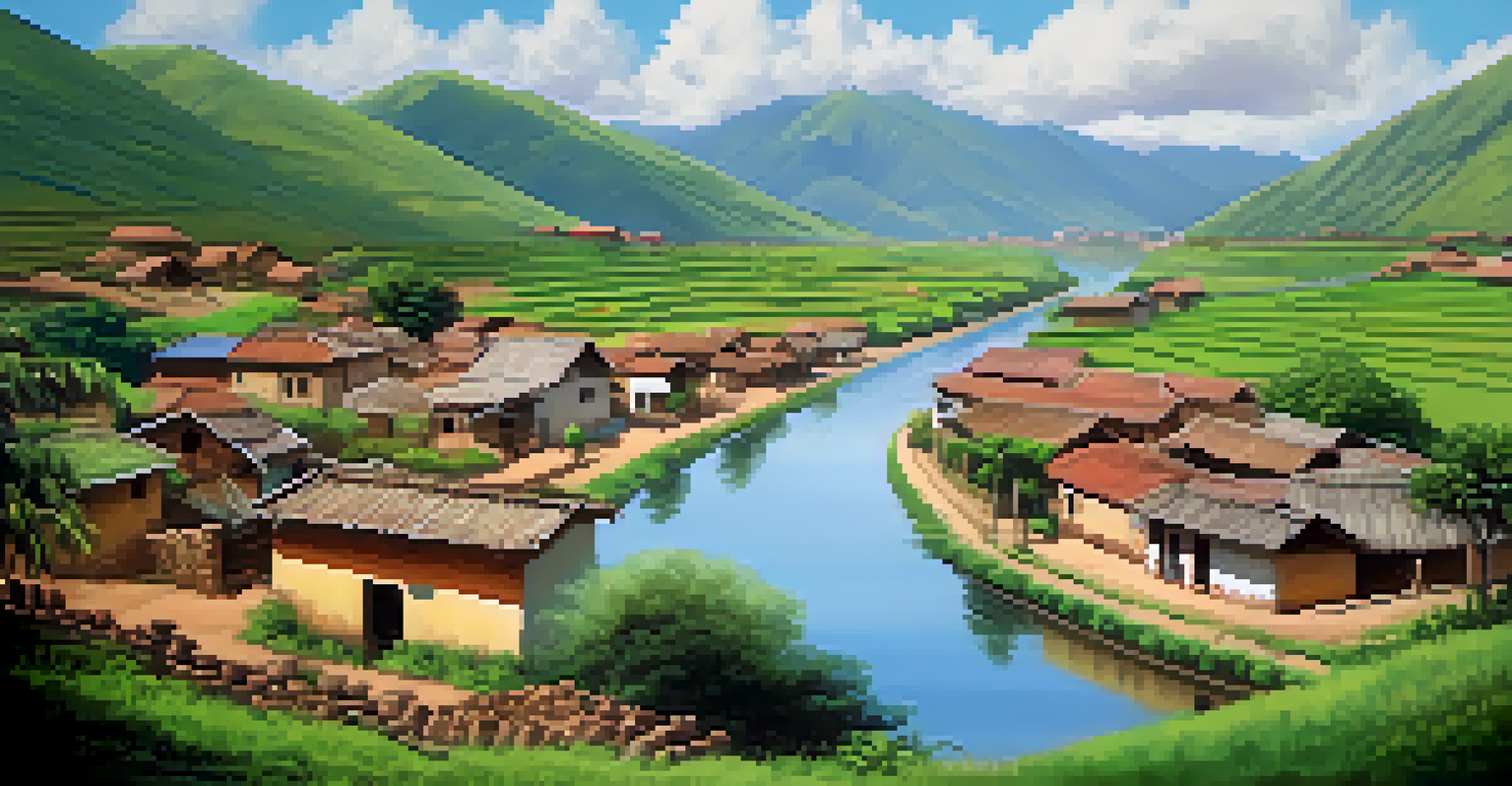Understanding the Magical Realism in Peruvian Literature

What is Magical Realism in Literature?
Magical realism is a unique literary style that blends the ordinary with the extraordinary. In this genre, fantastical elements are woven into the fabric of everyday life, creating a rich tapestry of narratives. It allows readers to experience the world through a lens where magic is accepted as part of reality, making the unbelievable feel familiar.
Magical realism is the genre that allows us to perceive the world through a lens where magic is accepted as part of reality.
This genre often reflects cultural and historical contexts, inviting readers to explore deeper truths about human experience. By incorporating magical elements, authors can challenge perceptions and provoke thought, encouraging us to question the boundaries of reality. It’s a literary form that speaks to the heart and the imagination, offering a fresh perspective on life.
In the context of Peruvian literature, magical realism serves as a powerful tool for storytelling. It allows authors to express the complexities of their cultural identity and the rich history of their country. Through this lens, the ordinary becomes extraordinary, revealing deeper meanings and connections.
Historical Roots of Magical Realism in Peru
The roots of magical realism in Peru can be traced back to the country's rich cultural heritage, blending indigenous traditions with colonial influences. This unique fusion creates a fertile ground for storytelling, where myths and legends coexist with contemporary realities. The historical backdrop of Peru, marked by social upheaval and rich traditions, provides a vibrant context for magical realism to flourish.

Peruvian writers have drawn inspiration from their surroundings, using magical realism to articulate the complexities of their identity. The genre allows them to explore themes of oppression, resilience, and cultural pride while incorporating elements from their indigenous roots. By reflecting on their past, these authors create narratives that resonate with both local and global audiences.
Magical Realism Blends Fantasy and Reality
This literary genre intricately weaves fantastical elements into everyday life, inviting readers to explore deeper truths about human experience.
Key literary figures such as Mario Vargas Llosa and Julio Ramón Ribeyro have played a pivotal role in shaping this genre in Peru. Their works often feature characters navigating the tumultuous landscape of societal change, where magic becomes a metaphor for hope and possibility. Through their storytelling, they invite readers to consider the deeper significance of the magical in the mundane.
Notable Peruvian Authors and Their Works
Several renowned Peruvian authors have made significant contributions to the realm of magical realism. For instance, the acclaimed writer Mario Vargas Llosa captures the essence of this genre in works like 'The Time of the Hero', where the line between reality and fantasy blurs. His narratives often challenge societal norms, reflecting the struggles of individuals against oppressive forces.
In the end, magical realism is a way of finding the extraordinary in the ordinary, illuminating the hidden layers of our reality.
Another notable figure is José María Arguedas, whose novel 'Deep Rivers' intricately weaves indigenous myths into the lives of his characters. Arguedas’ writing highlights the rich cultural tapestry of Peru, showcasing how magical elements can illuminate the human experience. His work invites readers to explore the profound connections between culture, identity, and the magical.
Additionally, authors like Alfredo Bryce Echenique and Laura Ramos have also embraced magical realism, each adding their unique voice to this vibrant literary tradition. Their narratives often reflect personal and collective histories, illustrating how magic can serve as a lens to understand profound truths about life and society.
Themes Explored in Peruvian Magical Realism
Peruvian magical realism often delves into themes of identity, culture, and the interplay between tradition and modernity. Authors explore how characters navigate their cultural heritage amidst the challenges of contemporary life. This exploration invites readers to reflect on their own identities and the impact of history on their lives.
Another prevalent theme is the juxtaposition of reality and fantasy, where magical elements highlight the absurdities of everyday life. This contrast not only entertains but also provokes thought, encouraging readers to question their perceptions of reality. By blending the magical with the mundane, authors create a space for introspection and discovery.
Cultural Heritage Shapes Peruvian Stories
Peruvian authors use magical realism to reflect their rich cultural identity, addressing themes of oppression, resilience, and social justice.
Additionally, the theme of social justice is prominent in many works, reflecting the struggles faced by marginalized communities in Peru. Magical realism becomes a voice for the voiceless, illustrating their experiences and aspirations. Through this lens, readers gain a deeper understanding of the socio-political landscape of Peru.
Cultural Significance of Magical Realism
Magical realism holds a significant cultural place in Peru, serving as a reflection of the country's diverse heritage. It allows for the expression of collective memories and shared experiences, fostering a sense of community. By embracing magical realism, Peruvian literature becomes a vessel for cultural preservation and innovation.
Moreover, this genre empowers authors to explore and critique societal issues, giving voice to those who are often marginalized. Through the lens of magic, writers can address complex realities in a way that resonates with readers on multiple levels. This approach not only captivates but also enlightens, inviting discussions on pressing social matters.
The cultural significance of magical realism extends beyond literature, influencing art, music, and film within Peru. This genre inspires a creative dialogue that bridges various forms of expression, showcasing the interconnectedness of different artistic disciplines. As a result, magical realism becomes a dynamic force in shaping Peru's cultural identity.
The Global Impact of Peruvian Magical Realism
Peruvian magical realism has transcended borders, influencing writers and artists worldwide. The genre's unique blend of fantasy and reality has resonated with diverse audiences, sparking interest in Latin American literature. As a result, many global authors have drawn inspiration from Peruvian works, incorporating magical realism into their narratives.
This global impact has also led to a greater appreciation for the richness of Peruvian culture and its literary contributions. Readers around the world are increasingly exploring works by Peruvian authors, seeking to understand the complexities of their narratives. This exchange fosters cultural awareness and appreciation of the diverse stories that shape our world.
Global Influence of Peruvian Literature
Peruvian magical realism has transcended borders, inspiring writers and artists worldwide while fostering cultural appreciation and dialogue.
Furthermore, adaptations of magical realism in film and visual arts have contributed to its global reach. Movies inspired by Peruvian literature often capture the essence of magical realism, inviting new audiences to engage with these enchanting stories. This cross-pollination of art forms highlights the universal themes found within Peruvian magical realism, making it relevant on a global scale.
The Future of Magical Realism in Peruvian Literature
The future of magical realism in Peruvian literature appears bright, with new voices emerging in the literary scene. Young authors are exploring innovative ways to blend magic and reality, pushing the boundaries of traditional storytelling. This evolution reflects the changing cultural landscape of Peru, where new ideas and perspectives are continually shaping narratives.
As contemporary issues such as climate change, globalization, and social justice come to the forefront, magical realism provides a unique platform for exploration. Authors are increasingly using this genre to address pressing challenges while weaving in elements of hope and resilience. This approach not only captivates readers but also encourages meaningful discourse on critical societal matters.

Moreover, the integration of digital media and technology into storytelling opens up new avenues for magical realism. Writers are experimenting with multimedia formats, creating immersive experiences that engage audiences in unique ways. As a result, the genre continues to evolve, ensuring that magical realism remains a vital and dynamic part of Peruvian literature.